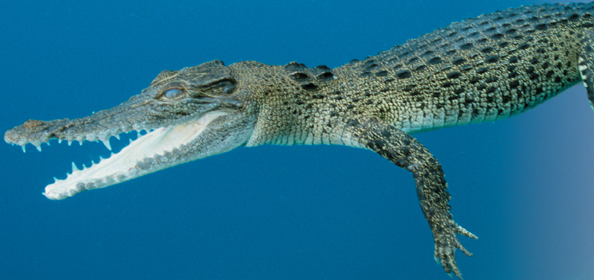Reptiles


Saltwater crocodiles, such as this young one, are the largest living reptiles and sometime reach 6 meters long. But that's still only half as long as their famous dinosaur ancestor, T. rex!
KEY CHARACTERISTICS of reptiles
Living reptiles, traditionally classified in the class Reptilia, are ectothermic vertebrates with dry, scaly skin; lungs; and amniotic eggs. Modern evolutionary classification now recognizes a larger clade Reptilia that includes living reptiles, extinct dinosaurs, and birds—the living descendants of one dinosaur group.
Feeding and Digestion Feeding methods vary by group; digestive systems—herbivores have long digestive systems to break down plant materials; carnivores may swallow prey whole
Circulation Two loops; heart with two atria and one or two ventricles
Respiration Spongy lungs provide large surface area for gas exchange; lungs operated by muscles and moveable ribs
Excretion Kidneys; urine contains ammonia or uric acid
Response Brain; well-developed senses including, in some species, infrared detectors that can spot warm-bodied prey in the dark
Movement Strong limbs (except snakes)
Reproduction Internal fertilization via cloaca; amniotic egg with leathery shell
Eco•Alert
Calling Doctor ‘Gator!
You might think of alligators mostly as killing machines, but their blood may soon provide medicines that can save lives. An alligator's immune system works quite differently from our own. Proteins in their white blood cells can kill multidrug resistant bacteria, disease-causing yeasts, and even HIV. Remarkably, these proteins work against pathogens to which the animals have never been exposed. Researchers are currently sequencing the genes for these proteins and hope to develop them into human medicines in the near future.
Table of Contents
- Formulas and Equations
- Applying Formulas and Equations
- Mean, Median, and Mode
- Estimation
- Using Measurements in Calculations
- Effects of Measurement Errors
- Accuracy
- Precision
- Comparing Accuracy and Precision
- Significant Figures
- Calculating With Significant Figures
- Scientific Notation
- Calculating With Scientific Notation
- Dimensional Analysis
- Applying Dimensional Analysis




